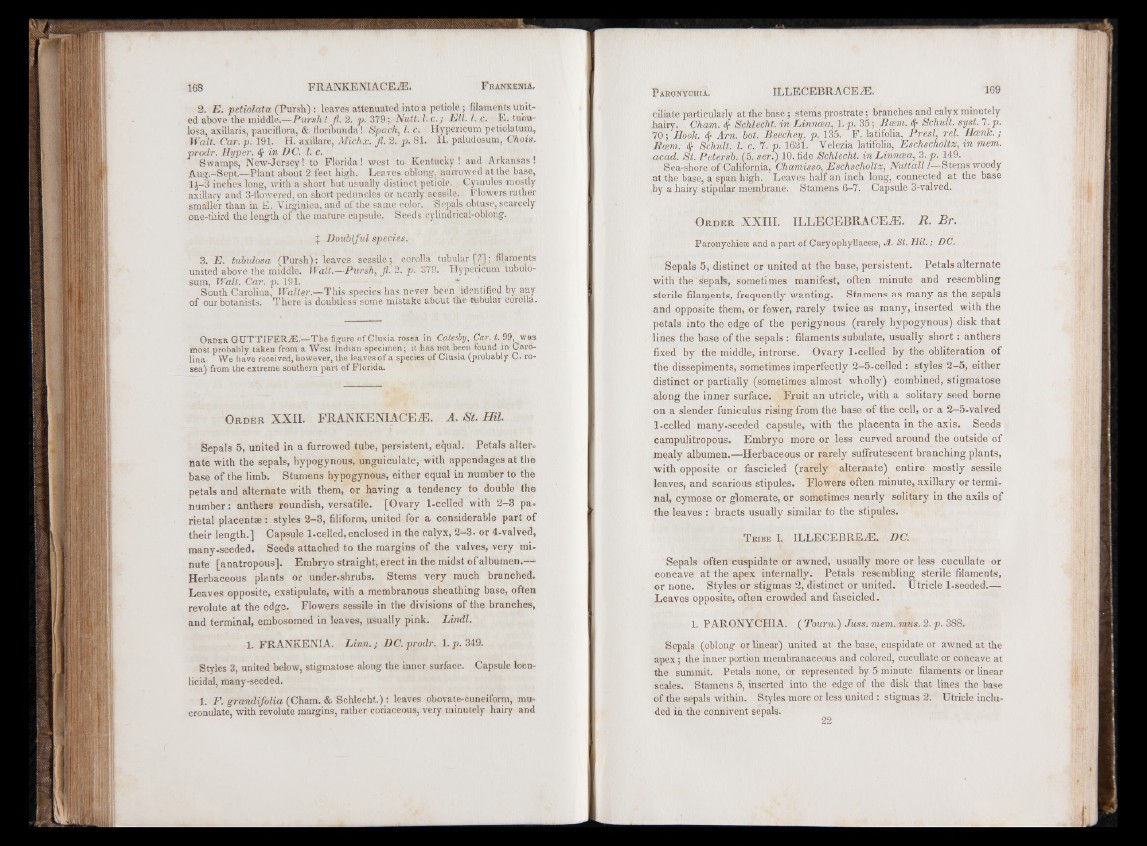
168 FRANKENIACEA3. F hankenia,
2. E. petiolata (Pursh) : leaves attenuated into a petiole ; filaments united
above the middle.—Pursh! ft. 2. p. 379; Nutt. t.c .; Ell. 1. c. E. tubu-
losa, axillaris, pauciflora, & floribunda! Spach, l. c. Hypericum petiolatum,
Walt. Car. p. 191. H. axillare, Michx. Jl. 2. p. 81. II. paludosum, Chois,
prodr. Hyper. cf in DC. 1. c.
Swamps, New-Jersey! to Florida! west to Kentucky ! and Arkansas!
Aug.-Sept.—Plant about 2 feet high. Leaves oblong, narrowed at the base,
l.j-3 inches long, with a short but usually distinct petiole. Cymules mostly
axillary and 3-flowered, on short peduncles or nearly sessile. Flowers rather
smaller than in E. Virginiea, and of the same color. Sepals obtuse, scarcely
one-third the length of the mature capsule. Seeds cylindrical-oblong.
J Doubtful species.
3. E. tubulosa (Pursh): leaves sessile; corolla tubular [?]; filaments
united above the middle. Walt.—Pursh, ft. 2. p. 379. Hypericum tubu'lo-
sum, Walt. Car. p. 191. *
South Carolina, Walter.—This species has never been identified by any
of our botanists. There is doubtless some mistake about the tubular corolla.
Order GUTTIFERjE.—The figure of Clusia rosea in Catesby, Car. t. 99, was
most probably taken from a West Indian specimen; it has not been found in Carolina
We have received, however, the leaves of a species of Clusia (probably C. rosea)
from the extreme southern part of Florida.
Or d e r X X II. FR A N K E N IA C E iE . A . S t. H il.
Sepals 5, united in a furrowed tube, persistent, equal. Petals alternate
with the sepals, hypogynous, unguiculate, with appendages at the
base o f the litnb. Stamens hypogynous, either equal in number to the
petals and alternate with them, or having a tendency to double the
number: anthers roundish, versatile. [Ovary 1-celled with 2 -3 parietal
placentae: styles 2 -3 , filiform, united for a considerable part o f
their length.] Capsule 1-celled, enclosed in the calyx, 2-3- or 4-valved,
many-seeded. Seeds attached to the margins o f the valves, very minute
[anatropous]. Embryo straight, erect in the midst o f albumen.—
Herbaceous plants or under-shrubs. Stems very much branched.
Leaves opposite, exstipulate, with a membranous sheathing base, often
revolute at the edge. Flowers sessile in the divisions o f the branches,
and terminal, embosomed in leaves, usually pink. Lindl.
1. FRANKENIA. L in n .; DC. prodr. 1. p. 349.
Styles 3, united below, stigmatose along the inner surface. Capsule locu-
licidal, many-seeded.
1. F. grandifolia (Cham. & Schlecht.) : leaves obovate-Cuneiform, mu-
cronulate, with revolute margins, rather coriaceous, very minutely hairy and
P aronychia. ILLECEBRACEiE. 169
ciliate particularly at the base ; stems prostrate; branches and calyx minutely
hairy. Cham, cf Schlecht. in Linncea, 1. p. 35; Rcem. <% Schult. syst. 7. p.
70; Hook. <$■ Am. bot. Beechey, p. 135. F. latifolia, Presl, rel. H a n k .;
Ram. % Schult. 1. c. 7. p. 1621. Velezia latifolia, Eschscholtz, in mem.
acad. St. Petersb. (5. ser.) 10. fide Schlecht. in Linncea, 3. p. 149.
Sea-shore of California, Chamisso, Eschscholtz, Nu tta ll!—Stems woody
at the base, a span high. Leaves half an inch long, connected at the base
by a hairy stipular membrane. Stamens 6-7. Capsule 3-valved.
Or d e r X X III. IL L E C E B R A C E iE . R . B r .
Paronycliieae and a part of Caryophyllaceae, A. St. Hil.; DC.
Sepals 5, distinct or united at the base, persistent. Petals alternate
with the sepals, sometimes manifest, often minute and resembling
sterile filanjents, frequently wanting. Stamens as many as the sepals
and opposite them, or fewer, rarely twice as many, inserted with the
petals into the edge o f the perigynous (rarely hypogynous) disk that
lines the base o f the sepals ; filaments subulate, usually sh o r t: anthers
fixed by the middle, introrse. Ovary 1-celled by the obliteration o f
the dissepiments, sometimes imperfectly 2—5-celled : styles 2—5, either
distinct or partially (sometimes almost wholly) combined, stigmatose
along the inner surface. Fruit an utricle, with a solitary seed borne
on a slender funiculus rising from the base o f the cell, or a 2—5-valved
1-celled many-seeded capsule, with the placenta in the axis. Seeds
campulitropous. Embryo more or less curved around the outside o f
mealy albumen.—Herbaceous or rarely suffruteseent branching plants,
with opposite or fascicled (rarely alternate) entire mostly sessile
leaves, and scarious stipules. Flowers often minute, axillary or terminal,
cymose or glomerate, or sometimes nearly solitary in the axils o f
the leaves : bracts usually similar to the stipules.
T ribe I. ILLECEBREiE. DC.
Sepals often cuspidate or awned, usually more or less cucullate or
concave at the apex internally. Petals resembling sterile filaments,
or none. Styles or stigmas 2, distinct or united. Utricle 1-seeded.—
Leaves opposite, often crowded and fascicled.
1. PARONYCHIA. ( Tourn.) Juss. mem. mus. 2. p. 388-
Sepals (oblong or linear) united at the base, cuspidate or awned at the
apex; the inner portion membranaeeous and colored, cucullate or concave at
the summit. Petals none, or represented by 5 minute filaments or linear
scales. Stamens 5, inserted into the edge of the disk that lines the base
of the sepals within. Styles more or less united: stigmas 2. Utricle included
in the connivent sepals.